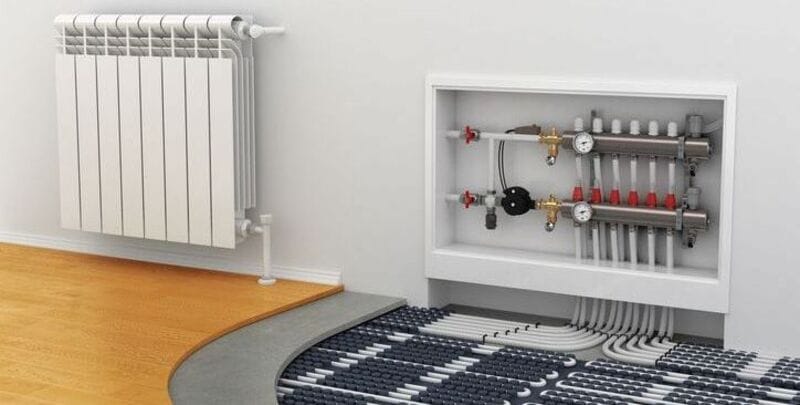
How Does a Hydronic Heating System Work?
Have you ever been wrapped in a warm towel right out of the bath or walked on a floor that's delightfully warm underfoot? That's the magic of a hydronic heating system, the ultimate home comfort solution.
Get ready to unravel the mysteries of this efficient and comfortable radiant heating and marvel as we answer the question: how does a hydronic heating system work?
The Science Behind Hydronic Heating
Hydronic heating has been around since Ancient Rome and involves water as a heat-conducting medium due to its better ability to transfer warmth energy than air.
Systems utilising this cooling technology consist of boilers that warm up liquid until it reaches an appropriate temperature. Surfaces heated by Hydronics are comfortable when touched but never too hot.
The way you feel warmness generated from these types of systems is unique: conduction, convection or radiant heat experienced through radiator panels, towel rails or more integrated alternatives like trench units installed beneath floors and underfloor solutions that combine efficiency with discretion.
All hydraulic setups provide silent operation while keeping cold draughts away!
The Role of Radiant Heat
When you feel the sun’s warmth on a bright summer day, its radiant energy provides this heat. Hydronic heating operates with precisely the same principle. Instead of simply blowing around warm air, these systems also radiate heat for thermal comfort and bring an even distribution in temperature to your home.
Heat emitters such as panel radiators use hydronic systems to pull in cool air, which heats up quickly and efficiently.

Key Components of a Hydronic Heating System
A well-managed machine operates the hydronic heating system, where every component plays an essential role. It consists mainly of boilers, pipes, radiators or underfloor heating systems and thermostats, which all coordinate together for the heat delivery.
The type of boiler you choose considers factors such as access to natural gas supply in your home area, layout preferences, and budgets involved when selecting one.
Circulation pumps provide flow through pipe conduits that transport heated water from the boiler towards any activated heat emitters (such as radiators or underfloor structures) present within the space, so it can radiate warmth throughout rooms via hot water transfer techniques.
Boilers: The Heart of the System
The boiler is the core of a hydronic system. It produces heat to warm water, which flows through its piping network. This setup uses various forms of energy, including electricity, wood pellets and gas/diesel-powered boilers.
To heat pumps for optimal efficiency. An internal pump enables hot liquid circulation throughout pipes, creating flow and return while providing much-needed warmth, whether it’s feeling cold outside or needing an extra comfortable bath experience afterwards.
The boiler is integral to most hydronic heating products and systems, ensuring everything runs smoothly no matter what type of energy source you choose.
Pipes: The Vessels for Heated Water
The hydronic system uses heated water from the boiler to transfer heat to radiators and other underfloor heating systems, utilising PEX (cross-linked polyethylene) pipes for efficient conduction and heat pump.
In this manner, the hot water flowing along these pipelines throughout the building transmits warmth, emitting heat waves in every area requiring a consistent temperature level. With such reliable circulation within the network offered by those specialised pipes – all areas are covered when it comes to keeping them sufficiently warm and cosy.
Radiators: The Heat Emitters
Radiators provide warmth to maintain a comfortable room temperature. Hot water is circulated through the radiator panels, resulting in a release of heat into space. In contrast, pipes beneath the floorboards can be used for an underfloor heating system.
They pass hot liquid that warms both floors, and the air rises without requiring additional fan technology.
Trenching at ground level allows cold air to come into contact with heated streams, too, ultimately leading them to emit warmness around the whole area effortlessly.
Thermostats: The Temperature Regulators
A hydronic heating system relies on thermostats to maintain an appropriate air temperature within each room.
Thermostat technology works by sensing the current temperature in a space and controlling the overall system output to correspond with your desired setting, simultaneously optimising comfort and energy conservation.
The Heating Process: From Boiler to Room
The art of hydronic heating is a finely tuned combination between engineering and science. It begins with selecting the ideal boiler for the hydronic heater system before water is heated in it and then pumped through copper piping into your home’s closed-loop system.
When thermostats detect that room temperatures drop below-desired levels, they activate the boiler, heat water, and pump heat until the target temperatures are achieved. Hydronic systems thus provide efficient distribution of warmth by using hot water circulating rooms.

Energy Efficiency and Cost Savings
Hydronic heating systems have proven to be an effective and cost-saving solution for central heating. Installing a condensing boiler that recaptures escaping heat boosts energy-saving potential by reducing gas emissions associated with other methods of traditional boilers.
When looking into central heating solutions, there is only one better option than hydraulic heating. It’s efficient and reliable while offering improved comfort all year round, regardless of whether a gas boiler in your home uses oil or gas-powered boilers as its fuel source.
Making Hydronic Heating Work for Your Home
Hydronic heating systems allow homeowners to select radiators and underfloor heaters that fit their style and needs. Not only this but retrofitting hydronic heaters into existing dwellings is also a possibility.
Note that changes in installation procedures may occur depending on the structure of these buildings. One of the hydronics’ most significant benefits is its customisability – hydronic panels can have colours matching your interior decor for an optimal combination of design and practicality.
Maintenance and Troubleshooting
A hydronic heating system must be maintained and troubleshot regularly to maintain efficiency. It includes eliminating air from the setup plus examining pressure relief valves.
To preserve the steady performance of the hydronic heating offers your home’s heat source over time, you will need regular maintenance from trained heating, ventilation and air conditioning (HVAC) technicians or plumbing contractors. They will typically handle the upkeep and always carry out the installation of a hydronic heating system.
These individuals have the expertise and experience to install and maintain complex heating systems.
Embrace the Benefits of Hydronic Heating
Hydronic systems are an excellent option for home heating as they feature efficient water-based heat conduction and the radiant principle.
Through components working harmoniously in a customisable setup for optimal efficiency, you can enjoy comfortable temperatures without overspending on energy costs, perfect if you are considering upgrading or replacing current heating setups.
So, why not make the switch to these hydronic heating panels?
Please note: This information is provided for advice purposes only. Regulations differ from state to state, so please consult your local authorities or an industry professional before proceeding with any work. See Cyber Air Conditioning’s Terms & Conditions here.
